Industry News, trenchless products, trenchless projects
40 Years after Original Tunnel, Robbins Returns to Russia
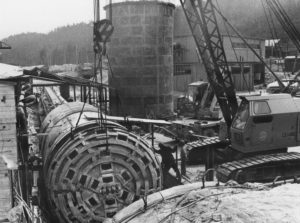 In 1979, a 4.56 m diameter Robbins Double Shield TBM was delivered to bore the Severomuysky Service Tunnel, a 15.3 km long railway through the remote mountains of Siberia. Now, 40 years after the original machine was delivered, Robbins is returning to the role. Two 10.37 m diameter Crossover (XRE) TBMs will bore the second Severomuysky Tunnel, clocking in at 15.5 km long and running through mixed ground and fault zones. The new rail line is needed due to limitations on carrying capacity on the current Baikal-Amur Mainline (BAM) railway through the area. Currently 16 million tonnes of cargo are carried through the existing Severomuysky tunnel but the Russian Government wants to increase cargo carrying capacity by more than six times in the region.
In 1979, a 4.56 m diameter Robbins Double Shield TBM was delivered to bore the Severomuysky Service Tunnel, a 15.3 km long railway through the remote mountains of Siberia. Now, 40 years after the original machine was delivered, Robbins is returning to the role. Two 10.37 m diameter Crossover (XRE) TBMs will bore the second Severomuysky Tunnel, clocking in at 15.5 km long and running through mixed ground and fault zones. The new rail line is needed due to limitations on carrying capacity on the current Baikal-Amur Mainline (BAM) railway through the area. Currently 16 million tonnes of cargo are carried through the existing Severomuysky tunnel but the Russian Government wants to increase cargo carrying capacity by more than six times in the region.
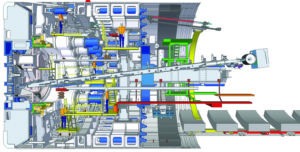 The largest global anthracite producer, Sibanthracite Group, is taking on the tunnel construction with management by VostokCoal Management Company. The companies, owned by Dmitry Bosov, aim to increase coal transport by up to 100 million tonnes per year through the addition of the second tunnel. “Robbins has established itself on the market as the best manufacturer of hard rock machines, which are able to provide the maximum penetration rate in hard rock. This is one of the determining factors in connection with the tight deadlines for the implementation of our project. Also, Robbins is the only manufacturer to build the Crossover TBM,” said a representative of Sibanthracite Group. Other aspects of the supply include a continuous conveyor for muck removal, rolling stock, spare parts, and cutting tools.
The largest global anthracite producer, Sibanthracite Group, is taking on the tunnel construction with management by VostokCoal Management Company. The companies, owned by Dmitry Bosov, aim to increase coal transport by up to 100 million tonnes per year through the addition of the second tunnel. “Robbins has established itself on the market as the best manufacturer of hard rock machines, which are able to provide the maximum penetration rate in hard rock. This is one of the determining factors in connection with the tight deadlines for the implementation of our project. Also, Robbins is the only manufacturer to build the Crossover TBM,” said a representative of Sibanthracite Group. Other aspects of the supply include a continuous conveyor for muck removal, rolling stock, spare parts, and cutting tools.
Sibanthracite Group chose Crossover technology for a number of reasons, geology being chief among them. “A Crossover type tunnel boring machine was selected for tunneling due to the fact that the construction of the tunnel will be carried out in difficult heterogeneous geological conditions (from unstable waterlogged soils to hard rock). The Crossover is able to operate in two modes: Open mode, used while boring in hard rock formations, and closed mode (with earth pressure balance), used when boring in unstable water-logged soils,” said the Sibanthracite representative.
The lessons learned during the first Severomuysky tunnel—the importance of probe drilling, consolidation grouting, and preventing a shielded machine from becoming stuck in fault zones or squeezing ground—are all part of the Crossover TBM solution. “I was a young engineer working at Robbins when the Double Shield TBM was delivered for the first tunnel, so it is a special honor to bring this new technology to the second Severomuysky Tunnel in Siberia,” said Robbins President Lok Home. “Per the contract Robbins is supplying Crossover TBMs for the new parallel rail tunnel—these machines are made to bore in highly variable ground conditions while maintaining good advance rates. With our latest technology we hope to again prove TBMs are the better choice over Drill and Blast when difficult ground conditions are to be encountered.”
The machines will be designed for varying water pressures, ranging from 5 to 20 bar. They will feature Water Inflow Control, a system that seals off the face and periphery and creates a safe working environment in which to dewater and consolidate ground. The machines will feature probe drill ports and capabilities for 360-degree probe drilling and grouting ahead of the excavation face, while the Robbins Torque-Shift System will enable the machines to bore through collapsing ground and other situations that demand high torque. The machines will also be designed with a belt conveyor in hard rock mode that can be switched out with a screw conveyor when crossing into soft ground.
Crews will bore through the Severomuysky Ridge, a mountain range in Buryatia and part of the Stanovoy Highlands, which separates the basins of the Upper Angara and Muya Rivers. “The second Severomuysky tunnel is located in one of the most geologically active areas of our planet—on the north-eastern flank of the Baikal rift zone. The region is characterized by high seismic activity, difficult geological and hydrogeological conditions against the backdrop of a harsh climate (the summer period lasts only 80-100 days, temperatures from + 39°C in summer to -58°C in winter). The construction work on the portals is complicated by the presence of permafrost as well,” said the Sibanthracite representative. Construction of the new tunnel is expected to begin in 2020 and take five years.
Image 1: The original 4.56 m diameter Double Shield machine was supplied for the Severomuysky Service Tunnel in 1979.
Image 2: The new 10.37 m Robbins Crossover (XRE) TBMs are designed for highly variable geology and will have a belt conveyor that can be switched out with a screw conveyor in challenging conditions.
Industry News, trenchless products
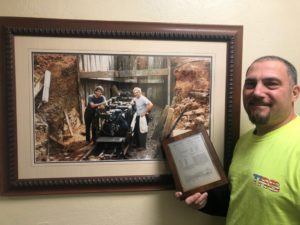 November 2019: Barbco, Inc. Co-Owner and CEO, Anthony R. Barbera was granted U.S. Patent #10465460 for the Barbco FlexBor tooling and technology on November 5, 2019! This is a proud moment in this East Canton, Ohio manufacturer’s storied 30-year history of driving the trenchless technology, horizontal boring, and underground manufacturing industries forward with world class capital equipment and cutting-edge technology. The FlexBor is an extremely cost-effective, environmentally safe trenchless method and tooling. The FlexBor is designed to virtually eliminate “frac-outs” / ”inadvertent returns” that are often associated with horizontal directional drilling and the use of bentonite.
November 2019: Barbco, Inc. Co-Owner and CEO, Anthony R. Barbera was granted U.S. Patent #10465460 for the Barbco FlexBor tooling and technology on November 5, 2019! This is a proud moment in this East Canton, Ohio manufacturer’s storied 30-year history of driving the trenchless technology, horizontal boring, and underground manufacturing industries forward with world class capital equipment and cutting-edge technology. The FlexBor is an extremely cost-effective, environmentally safe trenchless method and tooling. The FlexBor is designed to virtually eliminate “frac-outs” / ”inadvertent returns” that are often associated with horizontal directional drilling and the use of bentonite.
 The Patent Abstract reads: “A cutting assembly and method for drilling an underground borehole. The cutting assembly includes front and rear cutting heads of different diameters mounted on a shaft. An air passage defined through the cutting assembly may be placed in fluid communication with a pressurized remote air source and with a bore of a casing extending rearwardly from the cutting assembly. Pressurized air flows through the air passage and entrains cuttings produced by the front and rear cutting heads. A housing extends rearwardly from the larger diameter rear cutting head and an auger provided within the housing aids in directing cuttings into the casing. The auger rotates independently of the rest of the cutting assembly and may be configured to further reduce the size of the cuttings. A collar on the housing seals the borehole cut by the rear cutting assembly and aids in preventing frac-out.”
The Patent Abstract reads: “A cutting assembly and method for drilling an underground borehole. The cutting assembly includes front and rear cutting heads of different diameters mounted on a shaft. An air passage defined through the cutting assembly may be placed in fluid communication with a pressurized remote air source and with a bore of a casing extending rearwardly from the cutting assembly. Pressurized air flows through the air passage and entrains cuttings produced by the front and rear cutting heads. A housing extends rearwardly from the larger diameter rear cutting head and an auger provided within the housing aids in directing cuttings into the casing. The auger rotates independently of the rest of the cutting assembly and may be configured to further reduce the size of the cuttings. A collar on the housing seals the borehole cut by the rear cutting assembly and aids in preventing frac-out.”
Visit the Barbco website for more details.
Industry News, trenchless people, trenchless products
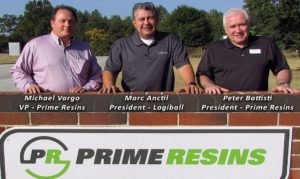 Conyers, GA – November 15, 2019 – USL Group announced today that it has acquired Logiball Inc., a leading manufacturer of trenchless pipe rehabilitation equipment headquartered in Quebec, Canada. Terms of the transaction were not disclosed.
Conyers, GA – November 15, 2019 – USL Group announced today that it has acquired Logiball Inc., a leading manufacturer of trenchless pipe rehabilitation equipment headquartered in Quebec, Canada. Terms of the transaction were not disclosed.
Founded in the early 1980s, Logiball holds a leading position in the manufacturing and supply of inflatable pipe plugs and test-and-seal injection packers for the maintenance and trenchless rehabilitation of collection systems and gravity pipes compromised by groundwater intrusion – a sizable segment of the general infrastructure sector known as the Inflow and Infiltration (I&I) market.
Logiball’s main product range is test-and-seal injection packers, which are used to confine and apply grouts for the repair of points of water ingress and egress from pipes, such as leaking joints or cracks. Logiball is the primary producer of these specialized products, which has allowed the company to forge a strong position in the niche of the I&I market.
“This acquisition provides channel synergies for both Logiball and our Prime Resins business, which makes chemical grouts. It will enable both companies to expand their reach in the growing I&I market space by leveraging their joint reputations and product offerings” said John Taylor, Director at USL Group. “Prime Resins has actively pursued growth in this market space, and the clear synergies with Logiball will lead to product improvement and expansion of use that will benefit the Trenchless Rehabilitation industry as a whole”.
About USL
Founded in 1981, USL Group of companies are market leaders in the provision of specialist civil engineering and construction solutions. For nearly four decades, USL Group has been at the forefront of cutting-edge resin and cementitious technology, combining high performing innovative products, first class operations, expert technical support and unrivalled customer service. Specializing in expansion joints, structural and liquid waterproofing, construction chemicals, concrete repair systems, injection resins and specialist safety & anti-slip products, USL boasts a comprehensive portfolio of products and a highly developed global network. For more information about USL, visit www.uslgroup.com.
Industry News, trenchless people, trenchless products
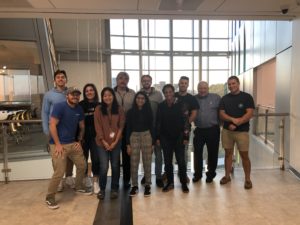 Recently two of NASTT’s very dedicated volunteers, Dennis Walsh and George Ragula, both of PSE&G, met with our Rutgers Student Chapter to give a presentation.
Recently two of NASTT’s very dedicated volunteers, Dennis Walsh and George Ragula, both of PSE&G, met with our Rutgers Student Chapter to give a presentation.
The presentation covered a project that is the new world record diameter 42” CIPL renewal that included an extremely complicated piping geometry involving seven bends in a u-tube configuration crossing a major parkway with a significant change in vertical elevation.
The project presentation was fascinating and the students were thrilled to have two industry experts on hand to answer questions and provide insight. Future presentations and job site visits are in the works.
Pictured are volunteers and student members:
Left to right, front row: Max Ritner, Sharon Xiao, Riya Maniar and Kendi Bailey.
Left to right, back row: Amil Muminovic, Demetra Tampasis, George Ragula, Ian Walczak, Anthony Genchi, Dennis Walsh and Troy Dittenhofer.
Industry News, trenchless products
New concept in vacuum excavator technology delivers on productivity
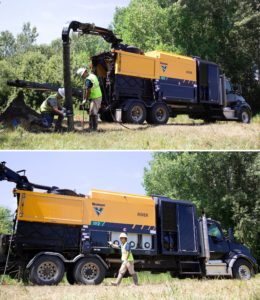 PELLA, Iowa, October 22, 2019 — Vermeer continues to propel the utility industry forward with the introduction of a new advancement in hydro-excavation. The Vermeer XR2 vacuum excavator is the industry’s first vacuum excavator equipped with a shaker deck that separates liquids and solids to allow contractors to stay on the jobsite longer, work efficiently and reduce disposal expenses. Material excavated with the XR2 is fed through an onboard deceleration tank that exits through an airlock onto a shaker deck where solids and liquids are then separated. The solid material is moved by conveyor toward the rear of the machine where it is discharged and can be carried away or left on the jobsite, depending on the material. Used, slurry water is pumped into one of the four XR2 holding tanks for disposal. This new concept in vacuum excavation allows contractors to carry 1500 gal (5678.1 L) of water to the job, work longer on the jobsite and can reduce hydro-excavator transport weights.
PELLA, Iowa, October 22, 2019 — Vermeer continues to propel the utility industry forward with the introduction of a new advancement in hydro-excavation. The Vermeer XR2 vacuum excavator is the industry’s first vacuum excavator equipped with a shaker deck that separates liquids and solids to allow contractors to stay on the jobsite longer, work efficiently and reduce disposal expenses. Material excavated with the XR2 is fed through an onboard deceleration tank that exits through an airlock onto a shaker deck where solids and liquids are then separated. The solid material is moved by conveyor toward the rear of the machine where it is discharged and can be carried away or left on the jobsite, depending on the material. Used, slurry water is pumped into one of the four XR2 holding tanks for disposal. This new concept in vacuum excavation allows contractors to carry 1500 gal (5678.1 L) of water to the job, work longer on the jobsite and can reduce hydro-excavator transport weights.
According to Adam Bates, product manager at Vermeer, the XR2 can help utility contractors mitigate utility strikes, improve operational efficiencies and create new opportunities. “Soft excavation methods are effective at reducing utility strikes, which have spurred the growth of the vacuum excavator market,” he explained. “However, DOT truck and trailer weight restrictions can impact the amount of material that crews can transport over the road, and the design of the XR2 helps teams get more hours of production.”
Digging performance
The Vermeer XR2 vacuum excavator has 1,500 gallons (5,678.1 L) of freshwater storage capacity capable of delivering up to 150 minutes of wand time at a rate of 10 gallons per minute (37.8 L/min). The adjustable pressure wand has a maximum output of 3,000 psi (206.8 bar) for challenging conditions but can be dialed back when working in sensitive areas.
The XR2 6-inch (15.2 cm) diameter hose produces up to 3,400 cfm (5,776.6 cmh) of suction for maximized digging performance. The excavator’s 21 foot (6.4 m) boom gives crews 260 degrees of swing, and the unit has a reverse flow feature to dislodge large chunks of material from the hose. All of these functions can be controlled through the unit’s fully functional remote.
For efficient truck repositioning, the design team integrated a unique power takeoff (PTO) feature that automatically transitions power from the vacuum system to the truck drive system and back. Crews no longer need to manually disengage and reengage the system every time the vacuum excavator is moved.
Separation design
Unlike traditional vacuum systems with spoil tanks, solids and liquids are separated using a shaker deck with auto-leveling capabilities up to a 10% grade. The deceleration tank includes six cyclones to aid with the separation process. The onboard, foldable 14 foot (4.3 m) solid material conveyor is controlled through the remote control, has a 180° rotating radius and a discharge height of 80 inches (203.2 cm) for efficient truck loading.
Capable of storing up to 1,500 gallons (5,678.1 L) of freshwater, the XR2 has four 500 gallon (1,892.7 L) liquid storage tanks. Processed liquids are first pumped into the unit’s reserved empty tank and then automatically switched to another tank as the freshwater supply is depleted and the reserve tanks fill up. The tanks are designed with sloped bottoms, so slurry can be efficiently pumped out before freshwater is replenished. Fresh and dirty water tank levels can be viewed anytime from the control station located on the side of the hydro-excavator.
Truck body
The Vermeer XR2 vacuum excavator is built on the back of a Kenworth T8800 truck with an Allison automatic transmission and Chelsea PTO. The unit has a curb weight of 39,000 pounds (17,690.1 kg), a freshwater transport weight of approximately 51,000 pounds (23,133.2 kg), at recommended capacity, and a return weight of an estimated 53,000 pounds (24,040.4 kg) when at the recommended full capacity of 10.5 ppg (1.26 SG) of slurry. With the conveyor in transport position, the truck measures 36 feet (11 m) long, has a width of 102 inches (259.1 cm) and a height of 138 inches (350.5 cm).
Expanding applications
“The XR2 was developed after listening to contractors talk about the limitations associated with traditional hydro-excavators,” explained Bates. “Contractors understand the soft excavation advantages of hydro-excavators but also felt limited by the production of many units because of weight concerns and water storage capacities. The design of the XR2 can help expand the use of vacuum excavation for everything from utility potholing and stitch boring to slot trenching and general construction.”
The Vermeer XR2 vacuum excavator was unveiled at the International Construction and Utility Equipment Exposition (ICUEE) and will be available in early 2020 in select regions. You can watch the unveiling on the Vermeer YouTube Channel.
For additional information, connect with your local Vermeer dealer or visit Vermeer.com.
Industry News, trenchless products, trenchless projects
The following is a post from Akkerman. For more details and additional job site photos, visit their website.
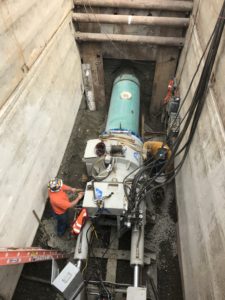 Northwest Boring Co. Inc. (NWB) of Woodinville, WA was subcontracted by Shoreline Construction for an emergency replacement of the City of Mill Creek’s failed 30-inch CMP stormwater pipeline that had been causing flooding in the suburban neighborhood, just north of Seattle.
Northwest Boring Co. Inc. (NWB) of Woodinville, WA was subcontracted by Shoreline Construction for an emergency replacement of the City of Mill Creek’s failed 30-inch CMP stormwater pipeline that had been causing flooding in the suburban neighborhood, just north of Seattle.
The need for the stormwater system’s repair became apparent when a sinkhole appeared in December 2017, between the Sweetwater Ranch and Douglas Fir neighborhoods. Temporary repair work was conducted, but another sinkhole developed in the same location just one month later. After inspection, it was determined that a failed coupler and damage to the 36-inch corrugated metal stormwater pipe was the root cause.
Because the City of Mill Creek had declared this an emergency project with a budget less than $300,000, a public bidding process was not required. Shoreline Construction was selected as the contractor, who subcontracted the trenchless work to NWB.
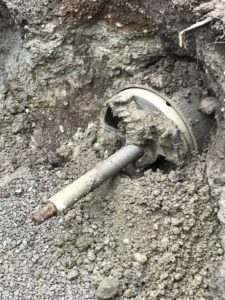 The alignments scheduled for replacement were positioned within a narrow easement between two homes at an 11-foot depth in difficult ground. With minimal real estate, the depth of installation and geological conditions, NWB knew that their guided boring system would be an ideal installation choice for the new stormwater connections.
The alignments scheduled for replacement were positioned within a narrow easement between two homes at an 11-foot depth in difficult ground. With minimal real estate, the depth of installation and geological conditions, NWB knew that their guided boring system would be an ideal installation choice for the new stormwater connections.
NWB employed the use of their Akkerman GBM 4800 Series Jacking Frame with a high-torque casing adapter attachment for auger boring. The combination made it possible to install the pilot tube passes and 10-foot pipe segments with the torque and jacking force of an auger boring machine but within a smaller shaft. The design utilized one launch shaft to initiate the runs from both directions which further reduced disruption to resident’s properties and saved on project costs.
The ground conditions present were glacial till with rock, which is typical for this region. This ground cannot be displaced with a standard pilot tube steering head so NWB arranged to use special tooling for up to 12,000 psi UCS ground. The drill bit of choice, the Rock Drill Adapter with TriHawk® drill bit, lead the pilot tube passes which established the 140 and 110-linear foot alignments at the necessary line and grade for gravity flow. Simultaneously, a soil appropriate lubrication regime was applied to flush the excavated cuttings back to the launch shaft for removal. (continued)
Crews then prepared to direct jack the 110 and 140-linear foot, 36-inch steel casing. In advance of the casing, NWB launched a guide rod swivel with a 36-inch cutter head which matched the 36-inch casing diameter. The swivel portion of the tooling absorbed the auger rotation while the cutter head, equipped with durable carbide gage cutter bit tooling, excavated the difficult ground. This second pass was completed with the guide rod swivel with cutter head for both stormwater sections.
The alignments were then finished with 27-inch Vylon® carrier pipe was positioned inside the casing and connections to the existing infrastructure were made.
From start to finish the entire project was finalized in just under a month, resolving the City’s dilemma in a timely manner with minor intrusiveness to residents.
 In 1979, a 4.56 m diameter Robbins Double Shield TBM was delivered to bore the Severomuysky Service Tunnel, a 15.3 km long railway through the remote mountains of Siberia. Now, 40 years after the original machine was delivered, Robbins is returning to the role. Two 10.37 m diameter Crossover (XRE) TBMs will bore the second Severomuysky Tunnel, clocking in at 15.5 km long and running through mixed ground and fault zones. The new rail line is needed due to limitations on carrying capacity on the current Baikal-Amur Mainline (BAM) railway through the area. Currently 16 million tonnes of cargo are carried through the existing Severomuysky tunnel but the Russian Government wants to increase cargo carrying capacity by more than six times in the region.
In 1979, a 4.56 m diameter Robbins Double Shield TBM was delivered to bore the Severomuysky Service Tunnel, a 15.3 km long railway through the remote mountains of Siberia. Now, 40 years after the original machine was delivered, Robbins is returning to the role. Two 10.37 m diameter Crossover (XRE) TBMs will bore the second Severomuysky Tunnel, clocking in at 15.5 km long and running through mixed ground and fault zones. The new rail line is needed due to limitations on carrying capacity on the current Baikal-Amur Mainline (BAM) railway through the area. Currently 16 million tonnes of cargo are carried through the existing Severomuysky tunnel but the Russian Government wants to increase cargo carrying capacity by more than six times in the region. The largest global anthracite producer, Sibanthracite Group, is taking on the tunnel construction with management by VostokCoal Management Company. The companies, owned by Dmitry Bosov, aim to increase coal transport by up to 100 million tonnes per year through the addition of the second tunnel. “Robbins has established itself on the market as the best manufacturer of hard rock machines, which are able to provide the maximum penetration rate in hard rock. This is one of the determining factors in connection with the tight deadlines for the implementation of our project. Also, Robbins is the only manufacturer to build the Crossover TBM,” said a representative of Sibanthracite Group. Other aspects of the supply include a continuous conveyor for muck removal, rolling stock, spare parts, and cutting tools.
The largest global anthracite producer, Sibanthracite Group, is taking on the tunnel construction with management by VostokCoal Management Company. The companies, owned by Dmitry Bosov, aim to increase coal transport by up to 100 million tonnes per year through the addition of the second tunnel. “Robbins has established itself on the market as the best manufacturer of hard rock machines, which are able to provide the maximum penetration rate in hard rock. This is one of the determining factors in connection with the tight deadlines for the implementation of our project. Also, Robbins is the only manufacturer to build the Crossover TBM,” said a representative of Sibanthracite Group. Other aspects of the supply include a continuous conveyor for muck removal, rolling stock, spare parts, and cutting tools.






